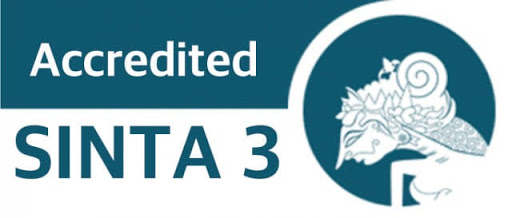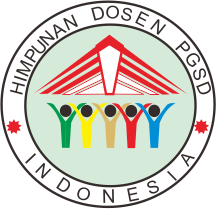ANALISIS KOLABORASI GURU DAN ORANG TUA DALAM PEMBELAJARAN IPA JARAK JAUH
Abstract
Artikel ini menganalisis kolaborasi antara guru dan orang tua dalam pendidikan sains jarak jauh dan menganalisis peran guru sekolah dasar. Metode yang digunakan adalah survei dengan sampel 48 orangtua siswa. Analisis data menggunakan analisis kuantitatif yang menekankan pada pengaruh peran guru dan peran orangtua terhadap keberhasilan belajar sains di sekolah anak Usia Sekolah. Berdasarkan analisis data, didapatkan bahwa nilai korelasi antara variabel peran guru terhadap hasil belajar sebesar 0,635 dan nilai t hitung lebih besar dari nilai t tabel. Sehingga dapat dikatakan terdapat pengaruh antara peran guru terhadap keberhasilan siswa di kelas, kedua nilai korelasi peran orang tua terhadap keberhasilan belajar memiliki nilai korelasi sebesar 0,375 dan nilai t hitung sebesar 2,582 yang artinya lebih besar dari t table. Sehingga dapat dipastikan pengaruh peran orangtua terhadap keberhasilan belajar siswa signifikan. Hasil pengukuran tersebut menunjukkan bahwa terdapat pengaruh peran guru dan orangtua terhadap keberhasilan siswa pendidikan anak Usia Sekolah dalam pembelajaran sains. Pemahaman konsep sains yang masih kaku dengan mengikuti buku acuan, keterbatasan alat, bahan, dan waktu, serta penerapan konsep sains yang belum mengacu pada lingkungan anak Usia Sekolah. Berdasarkan hasil penelitian tersebut, maka dapat disimpulkan bahwa kolaborasi guru dan orangtua perlu ditingkatkan sesuai dengan tujuan pengajaran sains pada anak Usia Sekolah untuk meningkatkan pembelajaran daring dan jarak jauh.
Keywords
Full Text:
PDF (BAHASA INDONESIA)References
Abuhammad, S. (2020). Barriers to distance learning during the COVID-19 outbreak: A qualitative review from parents’ perspective. Heliyon, 6(11). https://doi.org/10.1016/j.heliyon.2020.e05482
Aryani, N., Mudjiran, & Rakimahwati. (2020). The learning management model of early childhood education program based on children development. International Journal of Scientific and Technology Research, 9(1).
Aspers, P., & Corte, U. (2019). What is Qualitative in Qualitative Research. Qualitative Sociology, 42(2). https://doi.org/10.1007/s11133-019-9413-7
Chin, C., & Osborne, J. (2008). Students’ questions: A potential resource for teaching and learning science. Studies in Science Education, 44(1). https://doi.org/10.1080/03057260701828101
Currie, J. (2001). Early childhood education programs. In Journal of Economic Perspectives (Vol. 15, Issue 2). https://doi.org/10.1257/jep.15.2.213
D. Darmawan; D.Yatimah; K. Sasmita; R. Syah. (2020). Analysis of non-formal education tutor capabilities in exploring assessment for science learning. Jurnal Pendidikan IPA Indonesia, 9(2), 70–78. https://doi.org/10.15294/jpii.v9i2.24025
Dias, S. B., Hadjileontiadou, S. J., Diniz, J., & Hadjileontiadis, L. J. (2020). DeepLMS: a deep learning predictive model for supporting online learning in the Covid-19 era. Scientific Reports, 10(1). https://doi.org/10.1038/s41598-020-76740-9
Dong, C., Cao, S., & Li, H. (2020). Young children’s online learning during COVID-19 pandemic: Chinese parents’ beliefs and attitudes. Children and Youth Services Review, 118. https://doi.org/10.1016/j.childyouth.2020.105440
dos Santos, P. M., & Cirillo, M. Â. (2021). Construction of the average variance extracted index for construct validation in structural equation models with adaptive regressions. Communications in Statistics: Simulation and Computation. https://doi.org/10.1080/03610918.2021.1888122
Etikan, I. (2016). Comparison of Convenience Sampling and Purposive Sampling. American Journal of Theoretical and Applied Statistics. https://doi.org/10.11648/j.ajtas.20160501.11
Felson, J. (2017). Quantitative methods. In The Cambridge Handbook of Sociology. https://doi.org/10.1017/9781316418376.012
Fornell, C., & Larcker, D. F. (1981). Evaluating Structural Equation Models with Unobservable Variables and Measurement Error. Journal of Marketing Research, 18(1). https://doi.org/10.2307/3151312
Güven, S., & Yılmaz, N. (2017). Role And Importance Of Family At Preschool Children Environmental Education. European Journal of Sustainable Development, 6(4). https://doi.org/10.14207/ejsd.2017.v6n4p105
Hidayat, A. (2018). PLS SEM: Pengukuran Kecocokan Model (Inner dan Outer). 25 Agustus 2018.
Hilkenmeier, F., Bohndick, C., Bohndick, T., & Hilkenmeier, J. (2020). Assessing Distinctiveness in Multidimensional Instruments Without Access to Raw Data – A Manifest Fornell-Larcker Criterion. Frontiers in Psychology, 11. https://doi.org/10.3389/fpsyg.2020.00223
Isikoglu Erdogan, N., Johnson, J. E., Dong, P. I., & Qiu, Z. (2019). Do Parents Prefer Digital Play? Examination of Parental Preferences and Beliefs in Four Nations. Early Childhood Education Journal, 47(2). https://doi.org/10.1007/s10643-018-0901-2
Joo, Y. S., Magnuson, K., Duncan, G. J., Schindler, H. S., Yoshikawa, H., & Ziol-Guest, K. M. (2020). What Works in Early Childhood Education Programs?: A Meta–Analysis of Preschool Enhancement Programs. Early Education and Development, 31(1). https://doi.org/10.1080/10409289.2019.1624146
Karadaǧ, F., & Demirtaş, V. Y. (2018). The effectiveness of the philosophy with children curriculum on critical thinking skills of pre-school children. Egitim ve Bilim, 43(195). https://doi.org/10.15390/EB.2018.7268
Karavida, V., & Tympa, E. (2021). Parents’ Beliefs and Attitudes on Their Children’s Distance Education Performance during the COVID-19 Pandemic in Greek Preschool Settings. Journal of Education, Society and Behavioural Science. https://doi.org/10.9734/jesbs/2021/v34i630338
LaRue, A., & B, K. B. (2015). Transforming the Workforce for Children Birth Through Age 8: A Unifying Foundation. In Transforming the Workforce for Children Birth Through Age 8: A Unifying Foundation.
Marchant, G. J., Paulson, S. E., & Rothlisberg, B. A. (2001). Relations of middle school students’ perceptions of family and school contexts with academic achievement. Psychology in the Schools, 38(6). https://doi.org/10.1002/pits.1039
McArthur, J., Blackie, M., Pitterson, N., & Rosewell, K. (2021). Student perspectives on assessment: connections between self and society. Assessment and Evaluation in Higher Education. https://doi.org/10.1080/02602938.2021.1958748
McGrew, S., & Byrne, V. L. (2020). Who Is behind this? Preparing high school students to evaluate online content. Journal of Research on Technology in Education, 53(4). https://doi.org/10.1080/15391523.2020.1795956
Méndez-Suárez, M. (2021). Marketing mix modeling using PLS-SEM, bootstrapping the model coefficients. Mathematics, 9(15). https://doi.org/10.3390/math9151832
Mishra, P., Singh, U., Pandey, C. M., Mishra, P., & Pandey, G. (2019). Application of student’s t-test, analysis of variance, and covariance. Annals of Cardiac Anaesthesia, 22(4). https://doi.org/10.4103/aca.ACA-94-19
Ntanos, S., Kyriakopoulos, G. L., Arabatzis, G., Palios, V., & Chalikias, M. (2018). Environmental behavior of secondary education students: A case study at central Greece. Sustainability (Switzerland), 10(5). https://doi.org/10.3390/su10051663
O’connor, G., Fragkiadaki, G., Fleer, M., & Rai, P. (2021). Early childhood science education from 0 to 6: A literature review. In Education Sciences (Vol. 11, Issue 4). https://doi.org/10.3390/educsci11040178
Ornit Spektor-Levy, Yael Kesner Baruch, & Zemira Mevarech. (2013). Science and Scientific Curiosity in Pre-school—The teacher’s point of view. International Journal of Science Education, 35(13), 2226–2253.
Payne, P. G. (2005). Families, Homes and Environmental Education. Australian Journal of Environmental Education, 21(3). https://doi.org/10.1017/S0814062600000975
Reimers, F., Schleicher, A., Saavedra, J., & Tuominen, S. (2020). Supporting the continuation of teaching and learning during the COVID-19 pandemic. Oecd.
Sander, T., & Teh, P. L. (2014). The advantages and disadvantages of SmartPLS software. New Challenges of Economic and Business Development – 2014.
Sarstedt, M., & Cheah, J. H. (2019). Partial least squares structural equation modeling using SmartPLS: a software review. In Journal of Marketing Analytics (Vol. 7, Issue 3). https://doi.org/10.1057/s41270-019-00058-3
Shim, J. M. (2018). Involving the Parents of English Language Learners in a Rural Area: Focus on the Dynamics of Teacher-Parent Interactions. The Rural Educator, 34(3). https://doi.org/10.35608/ruraled.v34i3.396
Spektor-Levy, O., Baruch, Y. K., & Mevarech, Z. (2013). Science and Scientific Curiosity in Pre-school-The teacher’s point of view. International Journal of Science Education, 35(13). https://doi.org/10.1080/09500693.2011.631608
Stroetinga, M., Leeman, Y., & Veugelers, W. (2019). Primary school teachers’ collaboration with parents on upbringing: a review of the empirical literature. In Educational Review (Vol. 71, Issue 5). https://doi.org/10.1080/00131911.2018.1459478
Tatminingsih, S., Oktarianingsih, T., & Jovanka, D. R. (2021). Online Learning for Early Childhood (Case Study in Indonesia). Journal of Southwest Jiaotong University, 56(1). https://doi.org/10.35741/issn.0258-2724.56.1.11
Tavares, R., Vieira, R. M., & Pedro, L. (2021). Mobile app for science education: Designing the learning approach. Education Sciences, 11(2). https://doi.org/10.3390/educsci11020079
UNESCO. (2020). UNESCO Covid-19 Education Response. UNESCO, United Nations Educational, Scientific and Cultural Organization.
Vianasari, & Yanzi, H. (2015). Pengaruh Pemahaman Orang Tua Tentang Pentingnya Pendidikan Terhadap Keberhasilan Belajar Anak. Jurnal Kultur Demokrasi, 3(6).
Weech, T., Chu, C. M., Hirsh, S., Julien, H., Kennan, M. A., Velasquez, D. L., & Narayan, B. (2019). Information science education and library and information studies education: Transnational conversations. In Proceedings of the Association for Information Science and Technology (Vol. 56, Issue 1). https://doi.org/10.1002/pra2.98
Worth, K. (2010). Science in early childhood classrooms: Content and process. Early Childhood Research and Practice, Collected Papers from the SEED (STEM in Early Education and Development) Conference, 10.
Yoshikawa, H., Weiland, C., Brooks-Gunn, J., Burchinal, M., Espinosa, L., Gormley, W., Ludwig, J., Magnuson, K., Phillips, D., & Zaslow, M. (2013). Investing in Our Future: The Evidence Base on Preschool Education. Society for Research in Child Development.
DOI: http://dx.doi.org/10.33578/pjr.v6i5.8900
Refbacks
- There are currently no refbacks.
Copyright (c) 2022 JURNAL PAJAR (Pendidikan dan Pengajaran)

This work is licensed under a Creative Commons Attribution-NonCommercial-ShareAlike 4.0 International License.
JURNAL PAJAR (Pendidikan dan Pengajaran)
Secretariat
Program Studi Pendidikan Guru Sekolah Dasar
Gedung B1, FKIP Universitas Riau
Kampus Bina Widya Km. 12,5 Simpang Baru Panam
Pekanbaru Riau Indonesia 28293
e-mail : pajar@ejournal.unri.ac.id



